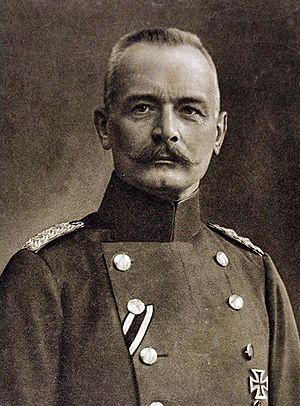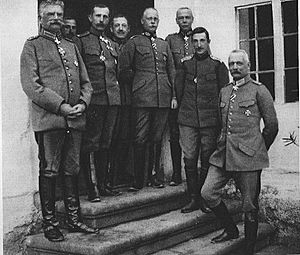Erich von Falkenhayn facts for kids
Quick facts for kids
Erich von Falkenhayn
|
|
|---|---|

Falkenhayn, c. 1913
|
|
| Prussian Minister of War | |
| In office 7 June 1913 – 21 January 1915 |
|
| Monarch | Wilhelm II |
| Prime Minister | Theobald von Bethmann Hollweg |
| Preceded by | Josias von Heeringen |
| Succeeded by | Adolf Wild von Hohenborn |
| Chief of the German Great General Staff | |
| In office 14 September 1914 – 29 August 1916 |
|
| Monarch | Wilhelm II |
| Chancellor | Theobald von Bethmann Hollweg |
| Preceded by | Helmuth von Moltke the Younger |
| Succeeded by | Paul von Hindenburg |
| Personal details | |
| Born | 11 September 1861 Burg Belchau, Kingdom of Prussia, German Confederation (now Poland) |
| Died | 8 April 1922 (aged 60) Potsdam, Prussia, Weimar Republic (now Germany) |
| Spouse | Ida Selkmann |
| Relations | Eugen von Falkenhayn (brother) Fedor von Bock (nephew) Henning von Tresckow (son-in-law) |
| Children | 2 |
| Profession | Military officer |
| Awards | Order of the Black Eagle Pour le Merite Military Order of Max Joseph |
| Military service | |
| Allegiance | |
| Branch/service | |
| Years of service | 1880–1919 |
| Rank | |
| Commands | Chief of the German General Staff 9th Army Army Group F (Ottoman Army) 10th Army |
| Battles/wars | Boxer Rebellion First World War |
Erich von Falkenhayn (born September 11, 1861 – died April 8, 1922) was a German general. He served as the Chief of the German General Staff during the First World War. This was a very important military leadership role. He held this position from September 1914 to August 1916.
Falkenhayn was removed from his role in 1916. This happened after several difficult events. These included the tough Battle of Verdun and the start of the Battle of the Somme. Also, the Brusilov Offensive by Russia and Romania joining the Allies changed the war. After this, he was given important commands in Romania and Syria. Some people criticized his leadership during the war. They felt he lacked the strong will needed for a big victory. Falkenhayn believed Germany could not win with one big battle. He thought they should aim for a peace agreement instead.
Contents
Early Life and Family
Erich von Falkenhayn was born in a village called Burg Belchau. This area is now part of Poland. His family had a long history, going back to 1504.
He had two brothers who also became important military figures. His brother Eugen became a general. His sister Olga was the mother of Field Marshal Fedor von Bock.
Military Career Beginnings
Falkenhayn started his military journey early. He became a cadet at age 11. In 1880, he joined the German Army as a Second Lieutenant. He worked as an officer in both infantry and staff roles.
He was known as a smart and thoughtful officer. Between 1896 and 1903, he took a break from the German Army. During this time, he worked as a military advisor for China. He helped set up some Chinese seaports.
Falkenhayn returned to German service in China. He was part of a Marine Battalion. He also fought in the Boxer Rebellion as a staff officer. His time in Asia made him a favorite of Kaiser Wilhelm II. He even became a military instructor for the Crown Prince.
Before World War I, Falkenhayn held several important positions. He became a section chief of the German General Staff. He also commanded a Guards Regiment. In 1912, he was promoted to Major General.
Prussian Minister of War (1913–1915)
In July 1913, Falkenhayn became the Prussian Minister of War. This meant he was in charge of the Prussian Army. He helped Germany prepare for war.
In July 1914, Germany told Austria-Hungary it would support them in a war. Falkenhayn, like other German leaders, did not expect a huge European war. But he quickly supported the idea. He encouraged Kaiser Wilhelm II to declare war. He was confident the German Army was ready. He even told the Chancellor, "Even if we perish over this, it will still have been worth it."
Chief of Staff (1914–1916)
Falkenhayn became the Chief of the German General Staff in September 1914. He took over from Helmuth von Moltke the Younger. Falkenhayn was 53, making him the youngest person to hold this top military job. He remained Minister of War for five more months.
He moved the main German military headquarters to Mézières. This placed it closer to the German armies in the west. He also ordered the southern armies to dig in. This was the start of trench warfare. Falkenhayn quickly saw that the original German war plan was failing. He tried to outsmart the British and French. This led to the "Race to the Sea" in northern France and Belgium. Both sides tried to get around the other's flank. They kept fighting until they reached the North Sea coast.
In November 1914, Falkenhayn realized Germany could not win a quick, decisive victory. He suggested making peace with Russia. This would allow Germany to focus on fighting France and Britain. However, other generals, like Paul von Hindenburg, disagreed. They thought peace with Russia was impossible.
Falkenhayn focused on the Western Front. He wanted to weaken the French and British armies. He also supported using submarines to attack enemy ships. In early 1916, he planned the Battle of Verdun. This was a long and bloody battle. Falkenhayn hoped to cause many casualties to the French Army. He wanted to do this while limiting German losses.
Falkenhayn believed the French would fight hard for Verdun. It was an important city for them. Verdun was also easy for German artillery to hit from three sides. Falkenhayn ordered the Crown Prince to pretend to attack Verdun. The real goal was to destroy the French army that came to defend the city.
However, Falkenhayn's plan did not work as expected. The Crown Prince and his staff tried to capture the city directly. French artillery caused heavy losses to the German army. Over a quarter of a million soldiers died during the battle. This led some to call Falkenhayn "the Blood-Miller of Verdun."
The French managed to limit their losses. General Philippe Pétain rotated divisions in and out of the battle. This helped keep their army from being completely destroyed.
On August 27, 1916, Romania declared war on Austria-Hungary. This, along with the struggles at Verdun and the start of the Somme offensive, led to changes. Falkenhayn was replaced as Chief of Staff by Hindenburg on August 29, 1916.
Commands in Romania (1916–1917)
After leaving his top staff role, Falkenhayn took command of the 9th Army. This was in Transylvania, starting in September 1916. He launched a joint attack against Romania with August von Mackensen.
Falkenhayn used clever tactics. He made the Romanians believe there would be no attacks in western Romania. His army fought the Romanian First Army. He then worked with Austrian forces to surround the Romanians. Despite some delays, Falkenhayn and Mackensen pushed the Romanian forces back into Russia by early 1917.
Palestine (1917–1918)
In July 1917, Falkenhayn was sent to command the Ottoman Yildirim Army Group. This was in Mesopotamia and Aleppo. In September 1917, he became the supreme commander of two Ottoman armies in Palestine. He held the rank of Field Marshal in the Ottoman Army.
In the Sinai and Palestine Campaign, Falkenhayn faced the British Egyptian Expeditionary Force. This force was led by General Edmund Allenby. Falkenhayn could not stop the British from taking Jerusalem in December 1917. He was then replaced by Otto Liman von Sanders.
However, Falkenhayn is remembered for a positive action. He helped prevent a battle for the Old City of Jerusalem. This protected its many holy sites. He also played a key role in stopping the forced removal of Jewish people from Palestine. The governor had planned this, and also wanted to evacuate Jerusalem's population during winter. Falkenhayn and other German officers stopped these plans.
Belarus (1918–1919)
In February 1918, Falkenhayn became commander of the 10th Army in Belarus. This unit was responsible for occupying Belarus after the Treaty of Brest-Litovsk. He oversaw the withdrawal of the 10th Army back to Germany in December 1918. He retired from the army in February 1919 when his unit was disbanded.
Retirement and Legacy
After retiring in 1919, Falkenhayn moved to his estate. There, he wrote his autobiography and several books about war and strategy. His war memoirs were translated into English. He wrote that Germany's declarations of war in 1914 were "justifiable but overly-hasty and unnecessary."
Falkenhayn passed away in 1922 near Potsdam. He was buried there.
Family Life
In 1886, Falkenhayn married Ida Selkmann. They had two children. Their daughter, Erika, married Henning von Tresckow. He was a general who was involved in the 20 July Plot to assassinate Hitler.
Assessment of his Leadership
Falkenhayn was a typical Prussian general in many ways. He was a skilled military leader. However, he did not believe in democracy. He once said that the Prussian army was strong because it was kept separate from political fights.
His military record was mixed. The attack at Verdun was a strategic failure. But during the campaign against Romania in 1916, he showed great skill. He drove the Romanians out of Transylvania. He also forced them north-east into Moldavia.
Some historians, like Winston Churchill, considered him one of the most capable German generals in World War I. Others noted that he sometimes lacked clear decision-making.
Falkenhayn was known as a loyal and honest friend and leader. His actions in Palestine in 1917 are seen as a positive part of his legacy. He prevented harm to the Jewish population there.
Honors and Awards
Falkenhayn received many awards for his service:
- Order of the Red Eagle, 1st Class (Prussia)
- Iron Cross (1914), 1st and 2nd Classes
- Pour le Merite (military), with Oak Leaves (Prussia)
- Order of the Black Eagle (Prussia)
- Grand Cross of the Military Merit Order, with Swords (Bavaria)
- Grand Cross of the Military Order of Max Joseph (Bavaria)
- Grand Cross of the Imperial Order of Leopold (Austria-Hungary)
- Grand Cross of the Royal Hungarian Order of St. Stephen (Austria-Hungary)
- Order of the Rising Sun, 4th Class (Japan)
- Order of the Sacred Treasure, 2nd Class (Japan)
- Order of the Double Dragon, Class II Grade II (China)
Images for kids
See also
 In Spanish: Erich von Falkenhayn para niños
In Spanish: Erich von Falkenhayn para niños





